
Lutetia
Encyclopedia
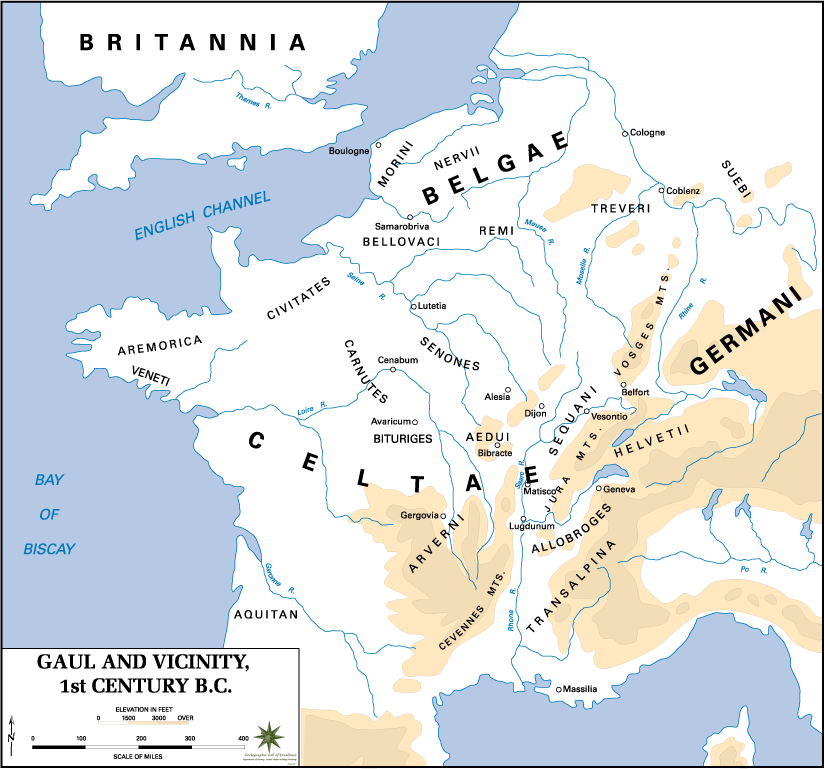
Gaul
Gaul was a region of Western Europe during the Iron Age and Roman era, encompassing present day France, Luxembourg and Belgium, most of Switzerland, the western part of Northern Italy, as well as the parts of the Netherlands and Germany on the left bank of the Rhine. The Gauls were the speakers of...
. The Gallo-Roman city was a forerunner of the re-established Merovingian town that is the ancestor of present-day Paris
Paris
Paris is the capital and largest city in France, situated on the river Seine, in northern France, at the heart of the Île-de-France region...
. Lutetia and Paris have little in common save their position where an island, the Île de la Cité
Île de la Cité
The Île de la Cité is one of two remaining natural islands in the Seine within the city of Paris . It is the centre of Paris and the location where the medieval city was refounded....
, created a convenient ford
Ford (crossing)
A ford is a shallow place with good footing where a river or stream may be crossed by wading or in a vehicle. A ford is mostly a natural phenomenon, in contrast to a low water crossing, which is an artificial bridge that allows crossing a river or stream when water is low.The names of many towns...
of the Seine
Seine
The Seine is a -long river and an important commercial waterway within the Paris Basin in the north of France. It rises at Saint-Seine near Dijon in northeastern France in the Langres plateau, flowing through Paris and into the English Channel at Le Havre . It is navigable by ocean-going vessels...
.
The primitive Λουκοτοκία (Strabon), Λευκοτεκία (Ptolemeus), Lutetia (Caesar
Caesar (title)
Caesar is a title of imperial character. It derives from the cognomen of Julius Caesar, the Roman dictator...
) maybe contain the Celtic
Celtic languages
The Celtic languages are descended from Proto-Celtic, or "Common Celtic"; a branch of the greater Indo-European language family...
root *luco-t- 'mouse' + -ek(t)ia = 'the mice', Breton
Breton language
Breton is a Celtic language spoken in Brittany , France. Breton is a Brythonic language, descended from the Celtic British language brought from Great Britain to Armorica by migrating Britons during the Early Middle Ages. Like the other Brythonic languages, Welsh and Cornish, it is classified as...
logod, Welsh
Welsh language
Welsh is a member of the Brythonic branch of the Celtic languages spoken natively in Wales, by some along the Welsh border in England, and in Y Wladfa...
llygod, Irish
Irish language
Irish , also known as Irish Gaelic, is a Goidelic language of the Indo-European language family, originating in Ireland and historically spoken by the Irish people. Irish is now spoken as a first language by a minority of Irish people, as well as being a second language of a larger proportion of...
luch (cf. Bibracte
Bibracte
Bibracte, a Gaulish oppidum or fortified city, was the capital of the Aedui and one of the most important hillforts in Gaul. It was situated near modern Autun in Burgundy, France. The material culture of the Aedui corresponded to the Late Iron Age La Tène culture,In 58 BC, at the Battle of...
, *bibro 'beaver' + -acti = 'the beavers') or another Celtic root luto-, luteuo- 'marsh', 'swamp' (Gaelic loth 'marsh', Breton loudour 'dirty') like in Lutudarum (Derbyshire, England); Lodève
Lodève
Lodève is a commune in the Hérault département in Languedoc-Roussillon in southern France. It is a sub-prefecture of the department.-Geography:...
(Luteua); Ludesse
Ludesse
Ludesse is a commune in the Puy-de-Dôme department in Auvergne in central France.-References:*...
(France); Lutitia (Germany), etc.
Gallic origins
Somewhere in the immediate area was the chief settlement or oppidumOppidum
Oppidum is a Latin word meaning the main settlement in any administrative area of ancient Rome. The word is derived from the earlier Latin ob-pedum, "enclosed space," possibly from the Proto-Indo-European *pedóm-, "occupied space" or "footprint."Julius Caesar described the larger Celtic Iron Age...
of the Parisii, a Gallic
Gaul
Gaul was a region of Western Europe during the Iron Age and Roman era, encompassing present day France, Luxembourg and Belgium, most of Switzerland, the western part of Northern Italy, as well as the parts of the Netherlands and Germany on the left bank of the Rhine. The Gauls were the speakers of...
people who settled in the area during the 3rd century BC. However, dendrochronological
Dendrochronology
Dendrochronology or tree-ring dating is the scientific method of dating based on the analysis of patterns of tree-rings. Dendrochronology can date the time at which tree rings were formed, in many types of wood, to the exact calendar year...
study of wooden pilings beneath the lowest stratum of the Roman north-south axis date the road's construction after 4 AD, more than fifty years after the Roman pacification of the region.
Roman Lutetia was founded above the flood-prone point where the Bièvre
Bièvre River
The Bièvre is a 32.8 km long river of the Île-de-France région that flows into the Seine in Paris. The name translates to "Beaver River" in English....
stream reaches the river
River
A river is a natural watercourse, usually freshwater, flowing towards an ocean, a lake, a sea, or another river. In a few cases, a river simply flows into the ground or dries up completely before reaching another body of water. Small rivers may also be called by several other names, including...
Seine
Seine
The Seine is a -long river and an important commercial waterway within the Paris Basin in the north of France. It rises at Saint-Seine near Dijon in northeastern France in the Langres plateau, flowing through Paris and into the English Channel at Le Havre . It is navigable by ocean-going vessels...
, centered on the slopes of the hill later dedicated to Saint Genevieve, on the left bank of the Seine (modern-day Latin Quarter
Latin Quarter
Latin Quarter is a part of the 5th arrondissement in Paris.Latin Quarter may also refer to:* Latin Quarter , a British pop/rock band* Latin Quarter , a 1945 British film*Latin Quarter, Aarhus, part of Midtbyen, Aarhus C, Denmark...
). There were outlying suburbs on an island across from the confluence, the Île de la Cité
Île de la Cité
The Île de la Cité is one of two remaining natural islands in the Seine within the city of Paris . It is the centre of Paris and the location where the medieval city was refounded....
, which was the Merovingian and modern centre of Paris
Paris
Paris is the capital and largest city in France, situated on the river Seine, in northern France, at the heart of the Île-de-France region...
.
Urbanization
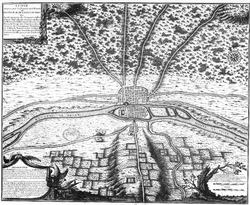
An aqueduct 26 km in length, with a flow rate estimated at 2000 cubic meters a day, watered the city with spring water collected from several points. To bridge the Bièvre valley at Arcueil-Cachan, a bridge was required, whose piers and ruined arches, still discernible, gave rise to the toponym Arcueil.
The amphitheatre, built into the slope of the hillside outside the city itself, is commonly referred to as Les Arènes de Lutèce
Arènes de Lutèce
The Arènes de Lutèce are among the most important remains from the Gallo-Roman era in Paris , together with the Thermes de Cluny...
. It was one of the largest such structures in Gaul.
Events
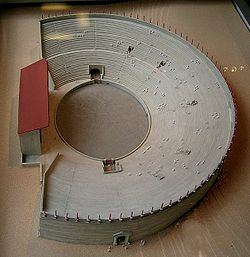
Roman Republic
The Roman Republic was the period of the ancient Roman civilization where the government operated as a republic. It began with the overthrow of the Roman monarchy, traditionally dated around 508 BC, and its replacement by a government headed by two consuls, elected annually by the citizens and...
in 52 BC during the conquest of Gaul
Gaul
Gaul was a region of Western Europe during the Iron Age and Roman era, encompassing present day France, Luxembourg and Belgium, most of Switzerland, the western part of Northern Italy, as well as the parts of the Netherlands and Germany on the left bank of the Rhine. The Gauls were the speakers of...
under Julius Caesar
Julius Caesar
Gaius Julius Caesar was a Roman general and statesman and a distinguished writer of Latin prose. He played a critical role in the gradual transformation of the Roman Republic into the Roman Empire....
.
The Lutetians backed the revolt of Vercingetorix
Vercingetorix
Vercingetorix was the chieftain of the Arverni tribe, who united the Gauls in an ultimately unsuccessful revolt against Roman forces during the last phase of Julius Caesar's Gallic Wars....
against the Romans under Caesar, reportedly contributing 8,000 men to Vercingetorix's army. It was garrisoned by Vercingetorix's lieutenant Camulogenus, whose army camped on the Mons Lutetius (where the Panthéon
Pantheon
-Mythology:* Pantheon , the set of gods belonging to a particular mythology* Pantheon * Pantheon, Rome, now a Catholic church, once a temple to the gods of ancient Rome* Any temple dedicated to an entire pantheon-Other buildings:...
is now situated). The Romans crushed the rebels at nearby Melun
Melun
Melun is a commune in the Seine-et-Marne department in the Île-de-France region in north-central France. Located in the south-eastern suburbs of Paris, Melun is the capital of the department, as the seat of an arrondissement...
and took control of Lutetia.
Under Roman rule, Lutetia was thoroughly Romanised with a population estimated at around 8,000 people. It did not have a great deal of political importance - the capital of its province, Lugdunensis Senona, was Agedincum (modern Sens, Yonne
Sens
Sens is a commune in the Yonne department in Burgundy in north-central France.Sens is a sub-prefecture of the department. It is crossed by the Yonne and the Vanne, which empties into the Yonne here.-History:...
). It was Christianised
Christianization
The historical phenomenon of Christianization is the conversion of individuals to Christianity or the conversion of entire peoples at once...
in the 3rd century, traditionally when St Denis
Denis
Saint Denis is a Christian martyr and saint. In the third century, he was Bishop of Paris. He was martyred in connection with the Decian persecution of Christians, shortly after A.D. 250...
became the city's first bishop. The process was not entirely peaceful - in about 250 St Denis and two companions were arrested and decapitated on the hill of Mons Mercurius, where Roman foundations have been found, thereafter known as Mons Martyrum (Martyrs' Hill, or Montmartre
Montmartre
Montmartre is a hill which is 130 metres high, giving its name to the surrounding district, in the north of Paris in the 18th arrondissement, a part of the Right Bank. Montmartre is primarily known for the white-domed Basilica of the Sacré Cœur on its summit and as a nightclub district...
).
Lutetia was renamed Paris in 360, taking its name from the Gallic Parisii
Parisii (Gaul)
The Parisii were a Celtic Iron Age people that lived on the banks of the river Seine in Gaul from the middle of the third century BC until the Roman era...
tribe
Tribe
A tribe, viewed historically or developmentally, consists of a social group existing before the development of, or outside of, states.Many anthropologists use the term tribal society to refer to societies organized largely on the basis of kinship, especially corporate descent groups .Some theorists...
name. The name had already been used for centuries as an adjective
Adjective
In grammar, an adjective is a 'describing' word; the main syntactic role of which is to qualify a noun or noun phrase, giving more information about the object signified....
("Parisiacus"). The legend of the Breton city of Ys
Ys
Ys , also spelled Is or Kêr-Is in Breton, and Ker-Ys in French , is a mythical city that was built on the coast of Brittany and later swallowed by the ocean...
suggests a different, if less likely, origin.
Around the same time, the city quarter on the left Seine bank, which housed the baths
Thermae
In ancient Rome, thermae and balnea were facilities for bathing...
, the theatres and the amphitheatre
Amphitheatre
An amphitheatre is an open-air venue used for entertainment and performances.There are two similar, but distinct, types of structure for which the word "amphitheatre" is used: Ancient Roman amphitheatres were large central performance spaces surrounded by ascending seating, and were commonly used...
, was gradually abandoned with the population being concentrated on the island, which received new fortification
Fortification
Fortifications are military constructions and buildings designed for defence in warfare and military bases. Humans have constructed defensive works for many thousands of years, in a variety of increasingly complex designs...
s. The classical theater began to be dismantled during the 4th century.
For the history of the city after its renaming, see the article on Paris
Paris
Paris is the capital and largest city in France, situated on the river Seine, in northern France, at the heart of the Île-de-France region...
.
Present-day remains
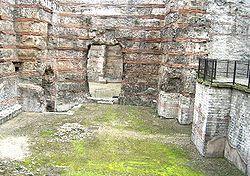
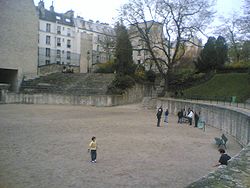

Latin Quarter
Latin Quarter is a part of the 5th arrondissement in Paris.Latin Quarter may also refer to:* Latin Quarter , a British pop/rock band* Latin Quarter , a 1945 British film*Latin Quarter, Aarhus, part of Midtbyen, Aarhus C, Denmark...
of the Left Bank, tucked behind apartment blocks, one may still see some remains of the 1st century amphitheatre
Amphitheatre
An amphitheatre is an open-air venue used for entertainment and performances.There are two similar, but distinct, types of structure for which the word "amphitheatre" is used: Ancient Roman amphitheatres were large central performance spaces surrounded by ascending seating, and were commonly used...
(Arènes de Lutèce
Arènes de Lutèce
The Arènes de Lutèce are among the most important remains from the Gallo-Roman era in Paris , together with the Thermes de Cluny...
). Furthermore, there are the remains of public baths at the Musée de Cluny
Musée de Cluny
The Musée de Cluny , officially known as Musée National du Moyen Âge , is a museum in Paris, France...
(frigidarium
Frigidarium
A frigidarium is a large cold pool of Roman baths. It would be entered after the Caldarium and the Tepidarium, which were used to open the pores of the skin. The cold water would close the pores. There would be a small pool of cold water or sometimes a large Swimming pool...
with vault intact and caldarium
Caldarium
right|thumb|230px|Caldarium from the Roman Baths at [[Bath, England]]. The floor has been removed to reveal the empty space where the hot air flowed through to heat the floor....
) and the Early Christian archeological crypt
Crypt
In architecture, a crypt is a stone chamber or vault beneath the floor of a burial vault possibly containing sarcophagi, coffins or relics....
under the Notre Dame
Notre Dame de Paris
Notre Dame de Paris , also known as Notre Dame Cathedral, is a Gothic, Roman Catholic cathedral on the eastern half of the Île de la Cité in the fourth arrondissement of Paris, France. It is the cathedral of the Catholic Archdiocese of Paris: that is, it is the church that contains the cathedra of...
forecourt
Forecourt
In architecture a forecourt is an open area in front of a structure's entrance.In archaeology, forecourt is the name given to the area in front of certain types of chamber tomb...
, now Place of Pope John-Paul II.
May 2006 findings
In May 2006, a road dating back 2,000 years was discovered at the site of Lutetia during expansion of the campus on University of Pierre and Marie Curie. The National Institute of Preventive Archaeological Research is currently excavating the site.During the excavation, remains of private houses containing Roman baths
Roman Baths
The Roman Baths complex is a site of historical interest in the English city of Bath. The house is a well-preserved Roman site for public bathing....
and heated floors were found. Over the next few weeks, however, archaeologists were to pull up the ruins to make way for a research center. Everyday items like flowerpots, bronze
Bronze
Bronze is a metal alloy consisting primarily of copper, usually with tin as the main additive. It is hard and brittle, and it was particularly significant in antiquity, so much so that the Bronze Age was named after the metal...
chains, ceramics
Ceramics (art)
In art history, ceramics and ceramic art mean art objects such as figures, tiles, and tableware made from clay and other raw materials by the process of pottery. Some ceramic products are regarded as fine art, while others are regarded as decorative, industrial or applied art objects, or as...
, and drawer handles were dug out. Many of these items were expected to be on exhibit in museums shortly after. Archaeologists acknowledge that this was the first site discovered from the reign of Roman emperor
Roman Emperor
The Roman emperor was the ruler of the Roman State during the imperial period . The Romans had no single term for the office although at any given time, a given title was associated with the emperor...
Augustus
Augustus
Augustus ;23 September 63 BC – 19 August AD 14) is considered the first emperor of the Roman Empire, which he ruled alone from 27 BC until his death in 14 AD.The dates of his rule are contemporary dates; Augustus lived under two calendars, the Roman Republican until 45 BC, and the Julian...
(63 BC-14 AD).
The builders
As far as details on the ancient builders, archeologists are in disagreement over the character of the neighborhood's builders. Some believe that a former GallicGauls
The Gauls were a Celtic people living in Gaul, the region roughly corresponding to what is now France, Belgium, Switzerland and Northern Italy, from the Iron Age through the Roman period. They mostly spoke the Continental Celtic language called Gaulish....
aristocracy
Aristocracy
Aristocracy , is a form of government in which a few elite citizens rule. The term derives from the Greek aristokratia, meaning "rule of the best". In origin in Ancient Greece, it was conceived of as rule by the best qualified citizens, and contrasted with monarchy...
, recruited by Rome
Rome
Rome is the capital of Italy and the country's largest and most populated city and comune, with over 2.7 million residents in . The city is located in the central-western portion of the Italian Peninsula, on the Tiber River within the Lazio region of Italy.Rome's history spans two and a half...
to govern the colony
Colony
In politics and history, a colony is a territory under the immediate political control of a state. For colonies in antiquity, city-states would often found their own colonies. Some colonies were historically countries, while others were territories without definite statehood from their inception....
settled in the area. The new Roman governors and noblemen did build the city in a Roman style, but certainly used materials found locally. Most of this is assumed because they had to have been wealthy enough to own a Roman bath found in one of the homes. A privately owned Roman bath was considered to be a status symbol
Status symbol
A status symbol is a perceived visible, external denotation of one's social position and perceived indicator of economic or social status. Many luxury goods are often considered status symbols...
among Roman citizens.
It is presumed that this particular dwelling
Dwelling
Dwelling, as well as being a term for a house, or for living somewhere, or for lingering somewhere, is a philosophical concept which was developed by Martin Heidegger. Dwelling is about making yourself at home where the home itself is a building that is a house...
was built in the first decade of the 1st century, at the end of emperor Augustus's reign, away from the administrative and commercial center of the Roman city. This neighborhood stood on the Roman main street (called "cardo maximus") that was originally paved for the Romans to cross the nearby Seine River and is today the Rue St. Jacques in Paris' fashionable 5th district.
Conservation of the findings
Due to Parisian official conservation policy, when construction work in Paris is planned, archaeologists review all building permits and the construction company must ask for official opinion to determine whether the site is of historical value. If the site proves significant in historical value, an excavation permit is then issued. One of the problems concerning the potential conservation of this site is the inherent destruction incurred by the excavation process, due to the need for expansion of the university facilities to help in the research of ancient and historic Paris.Popular culture
Lutetia is featured in the AsterixAsterix
Asterix or The Adventures of Asterix is a series of French comic books written by René Goscinny and illustrated by Albert Uderzo . The series first appeared in French in the magazine Pilote on October 29, 1959...
adventures. It is shown to be full of Gauls
Gauls
The Gauls were a Celtic people living in Gaul, the region roughly corresponding to what is now France, Belgium, Switzerland and Northern Italy, from the Iron Age through the Roman period. They mostly spoke the Continental Celtic language called Gaulish....
with some Roman Legionaries who patrol the streets. The city first features in Asterix and the Golden Sickle
Asterix and the Golden Sickle
Asterix and the Golden Sickle is the second volume of the Asterix comic book series, by René Goscinny and Albert Uderzo . It was first serialized in Pilote issues 42-74 in 1960.-Plot summary:...
, which almost entirely takes place in and around the city. It is also shown in Asterix and the Laurel Wreath
Asterix and the Laurel Wreath
Asterix and the Laurel Wreath is the eighteenth volume of the Asterix comic book series, by René Goscinny and Albert Uderzo . It was originally serialized in the magazine Pilote, issues 621-642, in 1971 and translated in to English in 1974.-Plot summary:The story begins in Rome where Asterix and...
where it is mentioned as the greatest city in the universe along with Rome
Rome
Rome is the capital of Italy and the country's largest and most populated city and comune, with over 2.7 million residents in . The city is located in the central-western portion of the Italian Peninsula, on the Tiber River within the Lazio region of Italy.Rome's history spans two and a half...
. Asterix and Obelix also make a brief stop in Asterix and the Banquet
Asterix and the Banquet
Asterix and the Banquet is the fifth volume of the Asterix comic book series, by René Goscinny and Albert Uderzo . It was first serialized in the magazine Pilote, issues 172-213, in 1963.-Plot:...
. Justforkix and Bravura
Bravura
In classical music, a bravura is a virtuosic passage intended to show off the skill of a performer, generally as a solo, and often in a cadenza. It can also be used as an adjective , or to refer to a performance of extraordinary virtuosity. The term comes from the Italian language for great skill....
are also mentioned to be from Lutetia.
Lutèce Falco 1991 is also the name of one of Paris Saint-Germain F.C.'s notable former Ultra groups.
Related facts
There is also an asteroidAsteroid
Asteroids are a class of small Solar System bodies in orbit around the Sun. They have also been called planetoids, especially the larger ones...
named 21 Lutetia
21 Lutetia
21 Lutetia is a large main-belt asteroid of an unusual spectral type. It measures about 100 kilometers in diameter . It was discovered in 1852 by Hermann Goldschmidt, and is named after Lutetia, the Latin name for Paris....
; and the element lutetium was named after the city, in honor of its discovery in a Paris laboratory.
Further reading
- Philippe de Carbonnières, Lutèce: Paris ville romaine (Gallimard 20012, ISBN 2-07-053389-1)

